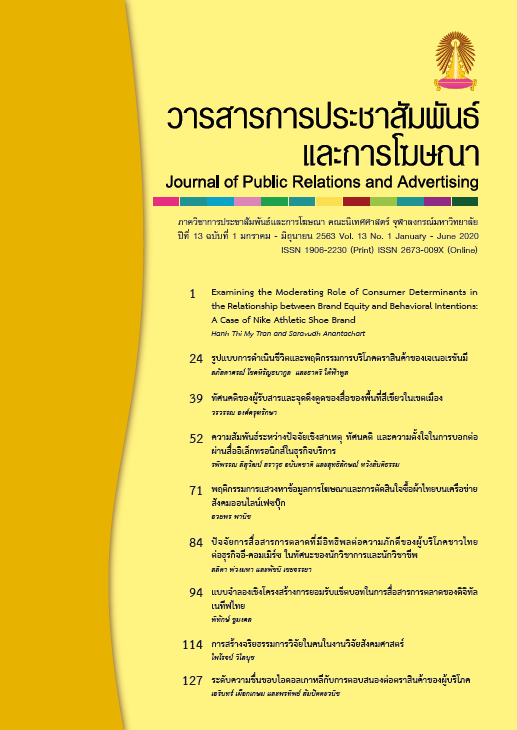Marketing Communication Factors Influencing Thai Customer Loyalty towards E-Commerce Business In the Opinion of the Academics and Professionals
Main Article Content
Abstract
This study is a qualitative research that aims to explore the opinions of academics and online marketers in relating to the marketing communication factors influencing Thai customer loyalty towards B2C e-commerce business in terms of e-tailing offering products directly to customers. This study employs the semi-structures interview methodology of five online marketing communication experts in the academic and professional fields. The results revealed that the marketing communication factors influencing Thai customer loyalty towards e-commerce are comprising of six factors which are product quality factor, product warranty factor, price factor, payment service factor, convenience access of e-commerce website factor, and information quality of e-commerce website factor.
Article Details
References
กมลรัฐ อินทรทัศน์. (2557). ทฤษฎีการสื่อสารและเทคโนโลยีสารสนเทศ. ใน ประมวลสาระชุดวิชาปรัชญานิเทศศาสตร์และทฤษฎีการสื่อสาร (หน่วยที่ 11-15). นนทบุรี: โรงพิมพ์มหาวิทยาลัยสุโขทัยธรรมาธิราช.
จิรธี กำไร. (2547). ก้าวแรกสู่ E-commerce. กรุงเทพฯ: เอส.พี.ซี. พริ้นติ้ง.
ณัฐพัชร์ ล้อประดิษฐ์พงษ์. (2549). คู่มือสำรวจความพึงพอใจลูกค้า. กรุงเทพฯ: ประชุมทองพริ้นติ้งกรุ๊ป.
ณัฐา ฉางชูโต. (2555). ปัจจัยการสื่อสารการตลาดในธุรกิจออนไลน์. วารสารนักบริหาร, 8(2), 72-81.
ไทยรัฐออนไลน์. ไขรหัส “ประเทศไทย 4.0” สร้างเศรษฐกิจใหม่ ก้าวข้ามกับดักรายได้ปานกลาง. วันที่เข้าถึงข้อมูล 2 พฤษภาคม 2559, แหล่งที่มา http://www.thairath.co.th/content/613903
ธงชัย สันติวงษ์. (2549). พฤติกรรมผู้บริโภคทางการตลาด (พิมพ์ครั้งที่ 11). กรุงเทพฯ: ประชุมช่าง.
ปริศนา เพชระบูรณิน. (2556). พาณิชย์อิเล็กทรอนิกส์กับสังคมไทย. วารสารวิชาการปทุมวัน, 3(1), 39-45.
ภาณุวัฒน์ รัตนดิษฐ์. (2555). ปัจจัยที่มีผลต่อความสำเร็จของธุรกิจออนไลน์ (วิทยานิพนธ์ปริญญามหาบัณฑิต). มหาวิทยาลัยเทคโนโลยีราชมงคลธัญบุรี, ปทุมธานี.
สุวิช ถิระโคตร. (2554). เว็บไซต์: ทฤษฎีและหลักการ. กรุงเทพฯ: โรงพิมพ์เดือนตุลา.
สุวิทย์ เมษินทรีย์. (2558). แนวคิดเกี่ยวกับประเทศไทย 4.0. วันที่เข้าถึงข้อมูล 2 พฤษภาคม 2559, แหล่งที่มา http://planning2.mju.ac.th/goverment/20111119104835_planning/Doc_25590823143652_358135.pdf
เสกสรร สายสีสด. (2549). ระบบสารสนเทศเพื่อการประชาสัมพันธ์. กรุงเทพฯ: ออลบุ๊คส์พับลิชชิ่ง.
เสาวคนธ์ หอมสุต. (2557). แบบจำลองสมการโครงสร้างความตั้งใจซื้อซ้ำของลูกค้าต่อพาณิชย์อิเล็กทรอนิกส์ประเภท B2C ในเขตกรุงเทพมหานคร (วิทยานิพนธ์ปริญญามหาบัณฑิต). สถาบันเทคโนโลยีพระจอมเกล้าเจ้าคุณทหารลาดกระบัง, กรุงเทพฯ.
สำนักงานเลขาธิการสภาผู้แทนราษฎร. (2559). ประเทศไทย 4.0. วันที่เข้าถึงข้อมูล 2 พฤษภาคม 2559, แหล่งที่มา http://library2.parliament.go.th/ejournal/content_af/2559/jul2559-5.pdf
ภาษาอังกฤษ
Albert, C. T., & Sanders, B. W. (2003). e-Business Marketing. New Jersey: Prentice Hall.
Clow, K. E., & Baack, D. (2004). Integrated Advertising, Promotion, and Marketing Communications (2nd ed.). New Jersey: Prentice Hall.
Constantinides, E. (2004). Influencing the online consumer’s behavior: The Web experience. Emerald Group Publishing Limited, 14(2), 111-126.
Gong-min, Z. (2010). Research on customer loyalty of B2C e-commerce. China-USA Business Review, 9(5), 46-52.
Jamal. A., & Anastasiadou, K. (2007). Investigating the effects of service quality dimensions and expertise on loyalty expertise on loyalty. European Journal of Marketing, 43(4), 398-420.
Kelley, Scott W., Douglas K., Hoffman, & Mark, A. D. (1993). A typology of retail failures and Recoveries. Journal of Retailing, 69(3), 429–452.
Molla, A., & Licker, P. S. (2001). E-Commerce systems success: An attempt to extend and respecify: The DeLone and McLean model of IS success. Journal of Electronic Commerce Research, 2(2), 131-141.
Napitupulu, T. A., & Aditomo, H. C. (2015). Factors affecting customer loyalty in business e-commerce: A case of Indonesia. Journal of Theoretical and Applied Information Technology, 76(3), 386-392.
Ribbink, D., Van Riel, A., Liljander, V., & Streukens, S. (2004). Comfort your online customer: quality trust, and loyalty on the internet. Managing Service quality, 14(6), 446-456.
Rust, R. T., & Zahorik, A. J. (1993). Customer satisfaction, customer retention, and market share. Journal of Retailing, 69(5), 193-215.
Wood, A. F., & Smith, M. J. (2005). Online communication: linking technology identity, and Culture (2nd ed.). Mahwah, New Jersey: Lawrence Erlbaum Associates.
Zeithaml, V. A., Parasuraman, A., & Malhotra, A. (2002). Service Quality Delivery Through Web Sites: A Critical Review of Extant Knowledge. Journal of the Academy of Marketing Science, 30(4), 362-375.


